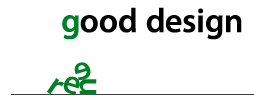As the still-emerging area called “Green Design” builds momentum among graphic designers and other design disciplines, I find myself growing increasingly frustrated. The use of this term, and perhaps even the perceived need to create such a term, implies to me that it is somehow different than good design in general.
Good design is not about incorporating the latest trends or styles, whether it be the hottest new colors or the appearance of “going green”. Mind you, I’m not suggesting that environmentally-responsible design is a fad. In fact, I believe that the need for sustainable design practices began when the earliest messages were put on paper and other non-renewable materials. Unfortunately, this need only gets stronger with time and the ongoing depletion and degradation of resources.
 I believe that good design is inherently “green”, or at least to the greatest degree possible within any given project. Good design is based on the deliberate and thoughtful consideration of the client, the audience and their experience, and the context in which the project occurs. No consideration of the context can be complete without an examination of the social, cultural and environmental landscape and the impact the project might have. If a designer fails to take these steps, or chooses to ignore these concerns, they are not truly engaging in the practice of good design.
I believe that good design is inherently “green”, or at least to the greatest degree possible within any given project. Good design is based on the deliberate and thoughtful consideration of the client, the audience and their experience, and the context in which the project occurs. No consideration of the context can be complete without an examination of the social, cultural and environmental landscape and the impact the project might have. If a designer fails to take these steps, or chooses to ignore these concerns, they are not truly engaging in the practice of good design.
While I applaud the fast-growing popularity of using materials such as FSC-certified papers, I am also witnessing a mindset that suggests that this is all there is to it when it comes to sustainable graphic design. This type of thinking, while obviously better than complete disregard, fosters a process in which these considerations are made only at the later stages of a project, rather than before the first concepts are even developed. By incorporating such concerns into the initial planning stages of a project we can have a much greater and more meaningful influence for positive change.
The use of terms such as “green design”, as if it is a niche or category of design, does little to enable the integration of sustainable practices into the design process. More to the point, I believe it marginalizes the very concerns that it seeks to address. Wouldn’t it be better if we changed the way we approach design to include the concerns of our society, rather the changing the language of design?


[…] of touting one’s “greenness”? Are we pushing back or pushing forward — getting past green. Similarly, could the desire for simplicity in design be a expression of our desire for simplicity […]